No man in America is identified with a sport in his city more than Sonny Hill is with basketball in Philadelphia. That is saying something, especially if you’re familiar with the “Philly Game.” Philadelphia has been a nerve center of the sport for a century. In the City of Brotherly Love, hoops has literally become part of the cultural experience, intricately woven into the city’s social fabric and psyche.
Much of that is Sonny’s doing. For some 50 years, his organization has touched the lives of tens of thousands of young men and women. JockBio.com contributor Zack Burgess sat down with Sonny to talk about his deep connection to basketball and recount some long-forgotten war stories from the sport’s past.
Sonny Hill was born in Philadelphia, Pennsylvania on July 22, 1936. A standout talent, he attended Northeast High School, where he was a multisport star.
|
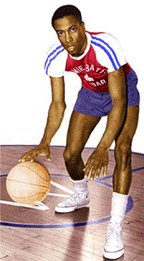
Sonny Hill,
courtesy of Bob Johnson
|
| |
|
| |
There were some great athletes around 8th and Lehigh in the 1950s—Guy Rodgers, Herb Adderley, Angelo Coia ... Sonny Hill. What role did sports play in the lives of the kids at Northeast High?
|
| |
|
|
| |
I went to Northeast High school because of Guy Rodgers. Guy Rodgers was my mentor. He was the one who encouraged me when I really wasn’t that good at basketball.
My first love was baseball. I was extremely good at it. I was sort of gifted to play it, and it came relatively easy. Basketball was something I really had to work at. But because of Guy—him mentoring me and inspiring me—it made it a little easier, because of our eventual relationshipl.
|
|
| |
|
|
| |
You were a big Warriors fan growing up.
|
|
| |
|
|
| |
When I was young, even though we identified more with the Globetrotters, I still loved the Philadelphia Warriors. I used to listen to their games on the radio and I took Paul Arizin as one of my heroes. My grandmother had a three-story house, so I had a room to myself, which was rare back in those days. After listening to a Philadelphia Warriors game, I would take a coat hanger and hang it on the closet door. I would take a sock and shoot into the coat hanger. I would be Paul Arizin. I really admired him.
|
|
| |
|
|
| |
Was your grandmother the biggest influence in your early life?
|
|
| |
|
|
| |
She was. She raised me. She gave me structure, discipline and a lot of love. She made sure I understood the difference between right and wrong. Just the basic things you need in life, things that enhanced me as I moved forward—not only in athletics, but the real world.
|
|
| |
|
|
| |
What are some of the moments that stand out from your high school career?
|
|
| |
|
|
| |
I got a chance to play with one of the great high school basketball players, and one the great players that this city has ever developed — James T. Parham. “T” and I had played together prior to going to Northeast, in the old Baptist Church League, for Reverend Leon Sullivan. Reverend Sullivan understood that using sports was a great way to reach young people. So I ended up playing both baseball and basketball for his Zion Baptist Church. People who saw T and I play regard us as one the really outstanding high school basketball backcourts.
|
|
Sonny graduated from Northeast High in 1955. University basketball programs weren’t handing out scholarships to undersized, inner-city African American guards back then, so college hoops was not on Sonny’s radar. But as luck would have it, a local connection led to a spot on the Central State Marauders. The all-black college was known for its track and basketball teams (though its most famous alumni are both singers, jazz chanteuse Nancy Wilson and opera star Leontyne Price). Central State’s most accomplished athlete in the 1950s was John Roseboro, who was signed off the Wilberforce, Ohio campus by the Brooklyn Dodgers in 1952.
|
|
| |
|
|
| |
What was the college experience like for you?
|
|
| |
|
|
| |
It was an eye-opener. In our era, no one in my family had ever gone to college. As a matter of fact, college was never even mentioned. I never heard one time in my household that you should consider getting some additional education beyond high school. Once you finished high school, you’d go and get yourself a job.
But when I came out of high school I came into contact with a gentleman who worked in the Department of Parks and Recreation by the name of Bob Dabney. He liked the fact that I was a really good basketball player and he spoke to me about his college—it was Central State College at that time. His family lived on the campus.
|
|
| |
|
|
| |
Dabney contacted the coach at Central State and he agreed to give you a look, sight-unseen?
|
|
| |
|
|
| |
Right. But when I got to Central State and went over to the coach, he was not too impressed. I was 5–9 and probably at that time 135 pounds. He said, “Well, we don’t have any grant and aid for you.”
Understand that you don’t get athletic scholarships at that level, you get grant and aid. So I said, “If you don’t have any grant or aid for me, I’m not going to be able to stay, because my family can’t afford it.”
|
|
| |
|
|
| |
So that was that?
|
|
| |
|
|
| |
No, because later I was over in the gym playing basketball. I could do some things then that a lot of people couldn’t do, some extraordinary things. Word got back that I was trapping basketballs on the backboard and shooting long jump shots. The coach suddenly changed his mind. He said, “You go over and see the bursar and the bursar will help you in terms of getting everything squared away.” So that’s how I got into Central State.
|
|
| |
|
|
 |
You dropped out after two seasons at Central State. Why?
|
|
| |
|
|
| |
The coach never really appreciated the things I could do as a basketball player. He had never started a freshman when I came to Central State and my ability forced him to start me. I think he resented the fact that I was the first freshman that he had ever started.
|
|
| |
|
|
| |
But you had a great a great year as a freshman?
|
|
| |
|
|
| |
I did. I was All-Conference my freshman year.
People sometimes wonder how good the conference was. Well, one of the teams in the conference was Tennessee State, who was coached by the great John McClendon—who went on to win three consecutive NAIA Tournaments.
And on that team was one of the great players in the country, a guy who went on the have an outstanding career in the NBA, and that’s Dick Barnett. Dick Barnett and I were the only two freshman that were All-Conference my freshman year.
|
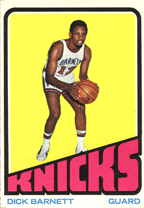 Dick Barnett, 1972 Topps
Dick Barnett, 1972 Topps |
| |
|
| |
And you led Central State to the NAIA Tournament.
|
| |
|
| |
Yes. I think we were only the third “black college” team to play. Yet despite my success, there was always this resentment to playing me, so I just felt that maybe Central State wasn’t the best place for me.
|
Sonny returned to Philadelphia. His plan was to get a job, settle down, raise a family with his wife, Edith, and start a career. It wasn’t immediately clear how basketball would fit into that picture. However, the game was growing in size, popularity and sophistication nationwide. Pro and semipro teams were always looking for talented floor leaders, and Sonny soon found himself a part of the Eastern Basketball League, one of several circuits formed after World War II. An expansion team, the Wilmington Jets, had recently moved to Allentown, PA and was looking for players.
|
|
| |
|
| |
You
joined the Jets in 1958.
|
| |
|
|
| |
It was a new team and they were having tryouts. I had already played with the best independent basketball teams in Philadelphia and had developed a big-time reputation.
The guy that was coaching the team was a guy by the name of Ace McCann. He was an outstanding player at LaSalle University a decade earlier.
Ace selected me to be on the team and I was the only black player on the Jets for the first part of the season. Soon, my good friend Ray Scott dropped out of Portland State, and I told the coach I had a guy that was 6-foot-9 who could play. So then it became the two us.
Jim Tucker was also on the Jets. He and Earl Lloyd were the first two black players on an NBA champion, with the Syracuse Nationals in 1955. Tucker mentored us. He took us under his wing as young guys. We were just coming out of our teenage years.
|
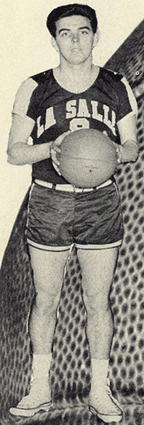 Ace McCann,
Ace McCann,
LaSalle yearbook photo |
| |
|
| |
Was the NBA ever a reality for you?
|
| |
|
| |
Being born in 1936, there was no NBA growing up. The biggest basketball of my generation was the Globetrotters. And that was true for blacks and whites. So I identified with the Globetrotters. Marcus Haynes was my hero and that’s who I identified with. Later in life I came in contact with him and we became lifelong friends.
The NBA was really just getting established as we were coming through in the 1950s. The NBA really didn’t hit its stride until Wilt Chamberlain came into the league in 1959. Wilt put the NBA on the big map, basketball-wise. Before that, when I would sit and dream about playing basketball, it was with the Globetrotters, I even coined a name for myself. I was going to be Sonny “Showboat” Hill. I was going to play that kind of basketball.
|
Sonny played for a decade in the Eastern League, always staying close to home. While playing for the Camden Bullets, he got a chance to know another basketball hero from his teen years, Paul Arizin.
|
|
| |
|
|
| |
How great was it to play with Arizin? Did he still have his killer jump shot?
|
|
| |
|
|
| |
When the Philadelphia Warriors were sold and moved to San Francisco in 1962, he was in his mid-30s and decided that he was going to stay here. He played for the Camden Bullets. Well, I had played for the Camden Bullets the year before. And here the next year I got a chance to play with the great Paul Arizin.
It was a thrill. We became really good friends. It was an honor. I tell people the story all the time, that when I was playing with Paul, he passed me the ball and said, “Shoot!” Now, he didn’t have to tell me to shoot, but it meant so much to me for him to tell me to shoot, because I respected him so much. And I was honored to know that he respected my game.
|
|
| |
|
|
| |
Who were some of the other people you played with and against in the Eastern League that could have been starters in the NBA?
|
|
| |
|
|
| |
You have to understand when I started playing in the Eastern League in 1958, there were only eight teams in the NBA. So you had eight teams in the NBA and about the same number of teams in the Eastern League. So you truly had the best of the best in both. Some Eastern League players, for one reason or another, didn’t get a chance to play in the NBA. It could have been because of the point-shaving scandals in the ’50s. It could have been because of the color line. It could be that they didn’t get the right opportunity.
|
|
|
|
|
|
| |
The style of play in the NBA was much more conservative, too.
|
|
| |
|
|
| |
That’s right. In the Eastern Basketball League, you could let your total game be played, whereas if we went to the NBA, you would have been required to play within the parameters of a structure.
I played against Sherman White, one of the premier players in the ’50s. He was the first of the tall players who could play inside-out, and inside-in, which was rare back in those days. Most big guys got rebounds, passed it to the little guy and just ran back down the floor. Sherman was that good.
I played against the great Hal Lear, who didn’t get the opportunity because of the color line. He was the first guy to average 40 points in the Eastern Basketball League. I played against John Chaney. I tell people all the time, he was a far better player than he was a coach! He was ahead of his time. I played against Bill Spivey who played at Kentucky. I played against “Chink” Gains, who got drafted by the Syracuse Nationals.
|
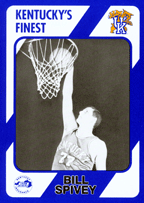 Bill Spivey card
Bill Spivey card |
| |
|
|
| |
Who was the best player you saw in the Eastern League that nobody’s heard of?
|
|
| |
|
|
| |
There was a tremendous player that I played against and I played with. His name was “Swish” McKinney out of Oakland, California. If you mention that name today, very few people would know who he is. He was a tremendous offensive player, great shooter.
|
|
|
|
| |
Is there a player today who reminds you of you?
|
| |
|
| |
A guy I played against in the Eastern League, and who played with the Globetrotters, called me up and said, “Sonny, I want you to know, that Allen Iverson—he plays like you.” So it’s not me thinking about who played like me, it was somebody who I had played against who said there was a similarity between Iverson’s speed, size and athletic ability—that there was a player closely related to the way that I played.
|
|
The Eastern League—which eventually morphed into the Continental Basketball Association—played a weekend schedule. Players worked normal jobs Monday through Friday and then gathered for one or two games over the weekend. Sonny continued to suit up for Eastern League clubs throughout the 1960s.
|
|
| |
|
|
|
Given that Eastern League players worked weekday jobs, it has been said that a lot of guys in your league actually made more than they would have in the NBA? Is that true?
|
| |
|
|
| |
Some of them did. Nobody in the NBA made over $20,000. Now don’t get me wrong, $20,000 was a lot of money in 1958. What people in the Eastern League got was a head start. Take a guy like Hal Lear. Hal made well over a $100 a game. So if you play 27 games, that’s about $3,000 right there. If you had a $10,000 a year job plus that other $3000, you could find yourself making upwards to $13,000 dollars a year while playing basketball—a game that you loved—on the weekends. At the same time you have that head start on your business career. That was the real difference. When the NBA guys finished, they now had to start their careers, while we were already into our business careers and moving forward. Most cases, we were better suited for success after basketball. When we got to be, say, 32-years-old, when most NBA careers were ending, we already had ten years on the job.
|
|
| |
|
|
|
You worked at a warehouse and got involved with the union. What were some of the other jobs your teammates found?
|
|
| |
|
|
| |
I worked for Teamsters Local 169. I got a job as a union representative in 1960. I stayed there for 34 years. There were players in the Eastern League who were educators. People worked for the city. Maybe they had government jobs. Some of them were salesman. There were a variety of things that we did for a living.
|
|
In the years after his playing days, Sonny became synonymous with urban basketball leagues. His first was the Baker League, a summer league in Philadelphia featuring top pro talent. Over the years the Baker League saw Hall of Famers like Wilt Chamberlain, Chet Walker and Earl Monroe take to the asphalt in Philadelphia.
|
|
| |
|
|
|
In 1960 you put together the Baker League, a summer pro league. What made you decide to start it, and how did you pull it together?
|
|
| |
|
|
| |
We were the first summer professional basketball league in the country. What happened was pros couldn’t play against amateurs and amateurs couldn’t play against pros, so there was no place for professionals—NBA stars like the Wilt Chamberlains, the Andy Johnsons, the Guy Rogers—to compete here in Philadelphia during the off-season. And then there were those of us in the Eastern League, the Hal Lears, the John Chaneys, the Sonny Lloyds, just so many players. We all used to get together and play on different nights in different areas of Philadelphia.
Guys would always ask, “Sonny, where we going to play tomorrow.” So one day I thought, instead of us just playing at different venues throughout the city, why don’t we organize? It started with four teams, North, South, West and my team. Soon four teams became five, five teams became six and it just grew beyond that. We started summer professional basketball and it took on its own identity. Leagues were being formed in Detroit, Los Angeles and other cities throughout the country.
|
|
| |
|
|
|
Bill Bradley once said that the Baker League saved his career. Obviously with players like Wilt, Earl the Pearl and Chet the Jet, the level of talent was off the charts. But how competitive were the games?
|
|
| |
|
|
|
The games then were at their height after the mid-1960s. That was the zenith. You had Earl Monroe, Archie Clark, Billy Cunningham, Wally Jones, Luke Johnson, Chet Walker, Willis Reed, Hal Greer, Cazzie Russell—so yeah, when Bill Bradley came in he had gone to Oxford for two years and he hadn’t really played any top-quality basketball. When he came back after being drafted by the Knicks, he was half-seasoned; he just wasn’t in basketball mental or physical shape. There were a lot of question marks about if he was going to be really that good. It just so happened he came to the Baker League and I embraced him. I put my arm around him and said, “Let’s work on what you need to work on.”
|
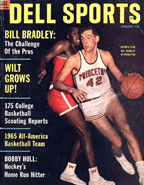 Bill Bradley,
Bill Bradley,
1965 Dell Sports |
| |
|
|
|
How frustrating was it when NBA teams started preventing their players from competing in the Baker League?
|
|
| |
|
|
| |
The NBA didn’t prevent their players from playing. Players themselves stopped playing because the love of the game changed. As NBA salaries grew, it became more difficult, and understandably so. It got so that you either had to have insurance or you had to have permission from the team to play. The biggest downturn is that players started to gain more money, and as they gained more money there was less love. Baker League games were played on concrete. You can’t get an NBA star to play on concrete today under any circumstances.
|
|
| |
|
|
|
In 1968 you started what is now called the Sonny Hill League. What were your goals when you began, and how has the reach of the league expanded?
|
|
| |
|
|
|
I started the league because there was gang warfare in the city of Philadelphia. I had built a reputation and had enough name recognition to start a league with five teams that represented five different areas of Philadelphia. The plan worked out extremely well. More and more people wanted to play. When we started out, it was primarily a high school league of really good players. But the needs changed and grew and I developed a Future League for 10th graders and under. Then we formed the Developmental League for sixth, seventh and eighth graders. At that time you could not have a college league, because colleges would not sanction summertime play. But when they eventually did, we started the Hank Gathers Summer League for college players. So we have all those divisions for kids to play in and grow.
|
   |






